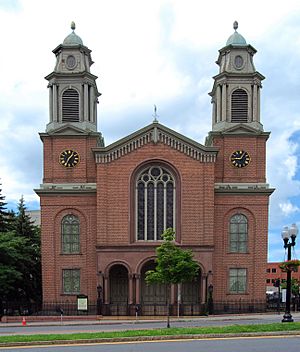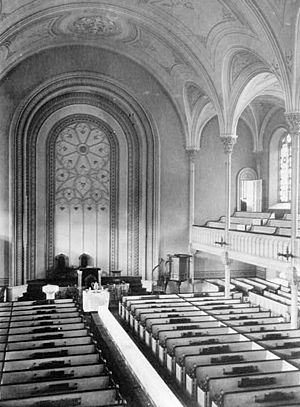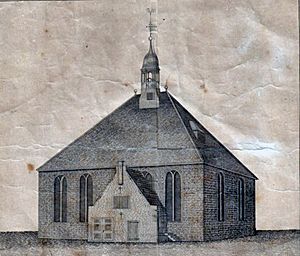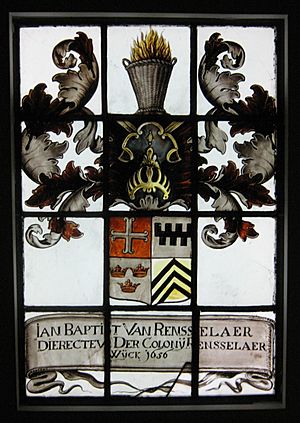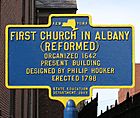First Church in Albany (Reformed) facts for kids
Quick facts for kids First Church in Albany |
|
|---|---|
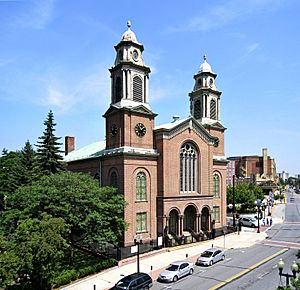
First Church in Albany in 2010
|
|
| Religion | |
| Affiliation | Reformed Church in America |
| Leadership | Rev. Dr. Mashona Walston |
| Location | |
| Location | Albany, New York, U.S. |
| Architecture | |
| Architect(s) | Philip Hooker |
| Groundbreaking | 1789 |
| Completed | 1797-1799 |
| Specifications | |
| Direction of façade | East |
| Length | 116 feet (35 m) |
| Width | 70 feet (21 m) |
| Spire(s) | 2 |
| Materials | Brick, stone |
| U.S. National Register of Historic Places | |
| Added to NRHP | January 21, 1974 |
| NRHP Reference no. | 74001214 |
| Website | |
| The First Church in Albany | |
The First Church in Albany is a very old and important church in Albany, New York. It is also known as the First Reformed Church or North Dutch Church. You can find it at North Pearl and Orange streets. This church is part of the Reformed Church in America.
A famous architect named Philip Hooker designed the building. It was built between 1797 and 1799. Because of its history and design, it was added to the National Register of Historic Places in 1974.
The church started way back in 1642. It served the Dutch people living in Fort Orange and nearby areas. It is the second oldest church group in New York and the oldest one in upstate New York. The building you see today is the fourth church building on this spot. It is the oldest church building still standing in Albany. Inside, you can see a pulpit that came from the Netherlands in 1656. It is the oldest pulpit in the United States!
Many important events happened here. A special service was held for Alexander Hamilton after he passed away. Theodore Roosevelt attended services when he was Governor of New York. Even Queen Wilhelmina visited the church for its 300th birthday. The church has been updated many times over the years.
The Church Building
The church is on the southwest corner of North Pearl and Orange streets. This area is just a few blocks north of downtown Albany. The land gently slopes towards the Hudson River, which is about 1,000 feet (300 meters) to the east.
Around the church, you'll find other interesting places. To the north is Clinton Square, which is part of the Clinton Avenue Historic District. The Palace Theatre, another historic building, is also nearby. Across North Pearl Street, there's a small grassy area and ramps leading to Interstate 787. Some tall buildings are also close to the highway. The church has its own parking lot to the south.
The church building is made of brick. The front part of the church has two tall towers, one on each side. All the windows on the front are stained glass and have stone frames. The main entrance has three round arches supported by smooth columns. Above the entrance, you can see "Reformed Dutch Church 1642" carved into the stone.
The roof is covered in copper. At the very top of the front gable, there is a weathervane. Each tower has a large clock and a louvered vent. The top of each tower has a small dome with an acorn-shaped decoration.
Inside, the church has beautiful vaulted ceilings supported by columns. The back wall of the chancel has five round arches with gold decorations. There are also offices and lecture rooms in a wing behind the main church area.
Church History
After Henry Hudson explored the river named after him in 1609, the Dutch government started settling the Hudson Valley. They built Fort Orange (which is now Albany) to claim the area. In 1624, someone was appointed to hold religious services for the settlers.
The church group officially started in 1642. They chose a minister, elders, and deacons. At first, services were held in a manor house, then a converted warehouse, and even a log cabin. In 1656, the first church building was built. It was a stone building that also served as a defense in case of attack. The original weathervane from that building is now in the church's archives, with a copy on the roof today.
In 1664, the English took control of the area from the Dutch. Fort Orange was renamed Albany. But the church continued its services without problems. In 1686, Albany became a city under British rule. The church was given land south of the city as payment for a loan. The church then rented this land to farmers.
Around 1689, the church began its work with the Mohawk people, a Native American tribe. This mission lasted for almost 50 years, and over 300 people were baptized. In 1715, the church built a larger stone church around the first blockhouse church, then took down the older building.
In 1720, the church officially became "The Reformed Protestant Dutch Church in the City of Albany." About 50 years later, as the American Revolution was approaching, the church helped create the independent group that became the Reformed Church in America (RCA). During the American Revolutionary War, the church held prayer meetings and even became a hospital for soldiers from the Continental Army who were hurt in the Battle of Saratoga.
In 1782, as the war was ending, General George Washington visited the church leaders to thank them for their support. Around this time, the church started holding services in English. Within eight years, English completely replaced Dutch as the main language used in services.
In 1789, work began on the current church building. Philip Hooker, a local architect, was chosen to design it. It took several years to build. In 1798, just before the project was finished, a local newspaper called it "a superb and elegant building." The project cost about $25,000.
Hooker's design was in the Georgian style. When it was first built, it was just the main block with a simpler front entrance. The windows had plain glass.
The 1715 church was sold and taken down in 1806. But its hand-carved pulpit was saved and used in the new church. In 1811, a second church building was opened nearby, known as the South Dutch Church.
In 1830, the church was made bigger with a new section at the back. This new part had lecture rooms and offices.
The 1850s were an important time for the church. In 1854, the church sold its remaining pasturelands. In 1858, another big renovation happened. This renovation changed the church's look a lot. A new front in the Romanesque style was added, and the windows were changed to stained glass. Inside, the vaulted ceiling was added, and the organ was made larger. They also added Central heating and new lecture rooms.
In 1903, the church sent a missionary to India. Her programs there continued for almost 50 years. About ten years later, the inside of the church was redecorated by Tiffany Studios. Green stained glass windows were added, along with green designs on the walls.
In 1918, the church started making changes to how it was run. The leaders approved its first yearly budget. This helped the church merge with the Second Dutch Church 20 years later. They became one church again, now called the First Church in Albany. To fit everyone, a new parish house was built the next year.
The improvements continued. In 1940, the inside was redecorated again. The sanctuary was repainted, and a dark wood screen was put in the chancel. The outside walls were cleaned, the towers were made wider, and the roof was redone. With these updates, the church welcomed then-exiled Queen Wilhelmina for its 300th anniversary in 1942. After World War II, a new, large organ was installed.
In the years that followed, the church made more changes. In the 1960s and 1970s, it bought nearby lots for parking for its members. Some land was also set aside for a small urban park. In 1973, the first female elder and deacon were chosen. The next year, a park called Clee Park was dedicated. The church also started summer drive-in worship, where people stay in their cars while the minister leads the service from an outdoor pulpit.
More renovations happened later. In 1988, the parish house was expanded with new offices, a lobby, and an elevator. With these improvements, the church celebrated its 350th anniversary in 1992.
Programs and Services
The church holds a service every Sunday morning, followed by coffee and conversation. In the summer, they have a drive-in service.
Every Monday and Wednesday, the church runs a food pantry. Food and other items are given to people who need them. These items are donated by church members. There are also special programs for children around the holidays. Church members also take part in the yearly CROP walk to help fight world hunger.
For children aged 9-12, the church has the 9Up Ministry. Kids meet during worship three out of four Sundays to work on art projects related to the church. They learn about the church year, the importance of art in worship, and their roles as church members.
Some support groups use the church's facilities. Alcoholics Anonymous meets in the church parlor once a week.
The church also supports international efforts with special collections at Christmas and Easter. Along with other RCA churches, First Church helps Global Mission (RCA). This group works with partners worldwide to help people in need, provide relief in disaster areas, and work with local communities.
Notable People
- Theodore Roosevelt
- Albert Janse Ryckman
See also
- Dutch Reformed Church
- History of Albany, New York
- National Register of Historic Places listings in Albany, New York


